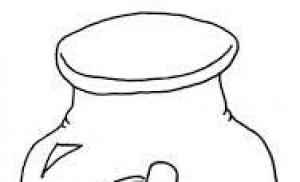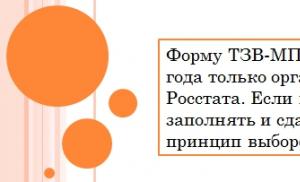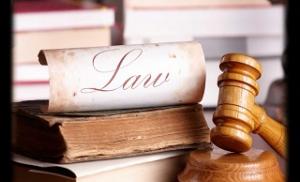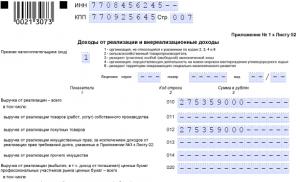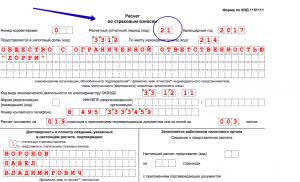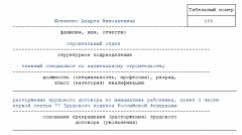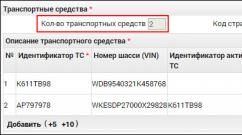Definition of a depreciation group. Depreciation groups of fixed assets and what applies to them
Each enterprise uses in its work various fixed assets that are its property and are used in the production of goods, the provision of services, and the performance of work. To take them into account, the initial cost is determined. Accounting during use is carried out at residual value.
All property objects wear out, depreciate over time: part of their value is transferred to the cost price. Depreciation is carried out over their entire useful life.
Dear readers! The article talks about typical ways to solve legal issues, but each case is individual. If you want to know how solve exactly your problem- contact a consultant:
APPLICATIONS AND CALLS ARE ACCEPTED 24/7 and 7 days a week.
It's fast and IS FREE!
Depending on the SPI, all fixed assets are classified into certain depreciation groups. For this, the OS Classifier and OKOF are used. In 2019, the grouping of fixed assets has undergone significant changes that you need to know for proper accounting.
Main nuances
As a general rule, enterprises depreciate assets over their useful lives (LI). They are determined by the OS Classifier (table).
OS grouping by Classifier:
| Depreciation group | SPI, years |
| First | 1-2 |
| Second | 2-3 |
| Third | 3-5 |
| Fourth | 5-7 |
| Fifth | 7-10 |
| sixth | 10-15 |
| seventh | 15-20 |
| eighth | 20-25 |
| ninth | 25-30 |
| Tenth | over 30 |
Confirmation of the date of commissioning of the OS is carried out by drawing up a separate act about this. It is necessary for the calculation of property tax, VAT deductions, the start of depreciation, as well as to confirm the initial cost of the property, its service life, and the depreciation group established for it.
Last changes
Previously, the coding of fixed assets was encrypted with 9-digit values that had the format XX XXXXXXXX. Since 2019, the new encoding is the form XXX.XX.XX.XX.XXX. These changes significantly transformed the structure of the OKOF.
Some of the names contained in the old classifier have been removed, and in OKOF-2017 they have been replaced by generalizing positions. For example, now there are no separate lines for unique types of various software, but a common object “Information resources in electronic form other” has appeared.
At the same time, the OF classifier contains new objects, which had no analogues in the previous version. These include equipment that did not exist in the last century.
Among the changes was the new location of some fixed assets in relation to belonging to the depreciation group. This indicates the introduction of other operational terms for them, and, consequently, a change in the period for writing off their initial value in tax accounting.
Innovations apply only to operating systems put into effect on January 1, 2019. It is not required to re-determine the depreciation group of fixed assets owned by the enterprise. Depreciation on them will be carried out in the same order.
For new property, special tools are provided for a convenient transition to the new OKOF - transitional keys between editions (direct and reverse). OKOF-1994 and 2019 are available in the order of Rosstandart No. 458 of 2019. They are presented in the form of a comparative table with a comparison of specific property objects. With its help, a new encoding is simply selected.
Important Notes
What is the purpose
Regardless of the form of ownership of the company, its size and activities, the issue of the efficiency of the use of fixed assets is one of the paramount. The competitiveness of the company's products, position in industrial production, and the financial condition of the organization depend on it. Therefore, the use of OKOF is especially important.
The main tasks that the OS classifier allows to solve:
- the possibility of increasing the economic efficiency of the use of property;
- access to detailed, conveniently grouped information about the work of the company;
- the emergence of the possibility of making the most profitable management decisions;
- simplification of tax administration and;
- reducing the likelihood of errors in accounting.
Control authorities devote maximum attention to checking the correctness of accounting, especially that conducted simultaneously with tax accounting. Therefore, it is important to know all the nuances and innovations in the reflection of fixed assets in reporting documents. This will eliminate the risk of erroneous filling and receiving fines.
Misrepresentation of the OS causes many problems for enterprises. An important term used in their accounting is "fixed assets", which include two types of property: tangible and intangible. Fixed assets are the company's tangible assets. This conclusion is made on the basis of concepts enshrined in legislation.
Classification features
The purpose of accounting is not only to reflect the presence, condition and movement of the fixed assets of the company, but also in the correct distribution of depreciation charges for cost items. To achieve this, different methods of classifying fixed assets are used.
The most comprehensive classifications:
- by functional purpose;
- by the degree of involvement in the work;
- by property legal affiliation;
- according to the ways of influencing the objects of work.
A more detailed classification of operating systems involves separating them into industry groups. Often this sign is underestimated, although together with the functionality, it helps to attribute depreciation to cost items. It is mandatory in accounting, analysis and reporting (mainly statistical) and is especially important in multidisciplinary structures.
The main feature of the classification of fixed assets in accounting and tax reporting is the service life (service life). The legislation allows firms to independently attribute their property to one or another depreciation group, based on the intensity of its use, the characteristics of economic and production processes and other factors that make it possible to determine the useful life.
The most widespread practice is to use a common standard based on the division of fixed assets into single depreciation groups. The most detailed classification, logically related to grouping by age, by natural property is called the OKOF classification.
Registration
Fixed assets should be registered step by step in a certain sequence.
First you need to determine if the object belongs to the OS. The service life of an asset in tax accounting must be more than 12 months and have a value of 100 thousand rubles (clause 1, article 256 of the Tax Code of the Russian Federation). If these criteria are met, it is impossible to attribute the cost of property to expenses at a time. You need to choose the appropriate group for it and the useful life. After that, you can write it off through depreciation.
The next step is to select the depreciation group. It must begin with classification. If the type of property was not found in it, it is worth contacting the OKOF. First of all, the code of the type of fixed asset, consisting of 9 digits, is determined. The group is located by the first 6 designations, which must match the Classifier encoding.
Fixed assets available in the Classifier:
| OS | Group | Service life, years | Where does it belong |
| a printer | II | 2-3 | Electronic computers |
| Personal computer, laptop | II | 2-3 | |
| MFP printing | III | 3-5 | Blueprinting tools |
| Music center, plasma TV | IV | 5-7 | TV and radio receiving equipment |
| Office furniture | IV | 5-7 | Furniture for printing, trade, consumer services |
| A car | III | 3-5 | Cars |
| Freight car | III | 3-5 | Trucks with carrying capacity up to 0.5 t |
The next step is to determine the useful life of the OS. You can select any number of years within the specified limits. For property worth more than 100 thousand rubles, it is desirable to establish the same period in tax and accounting records in order to avoid discrepancies.
Sometimes the necessary means is not available either in the Classifier, but in the OKOF. In this case, it can be determined according to the manufacturer's recommendations or technical documents. Other options are sending a request to the manufacturer or referring to the clarifications of the Ministry of Economic Development.
At the final stage, you need to spend the life of the OS according to the documentation - enter information into the inventory card. When setting different deadlines for tax and accounting, this must be reflected.
OS classification according to OKOF:
Establishment algorithm
To correctly classify a property object as an OS, it is necessary to check whether it has the following signs:
- the ability to bring economic benefits to the owner in future activities;
- the company does not plan to resell it further;
- long-term use (more than 12 months) is possible.
If the property meets all the indicated characteristics, it is taken into account as a fixed asset.
All fixed assets are classified into groups with distinctive features depending on the useful life, which is understood as the time during which the object can serve the achievement of the company's goals in economic and production activities.
In accounting and tax accounting, OS classification is used. The value of already recorded property, the use of which continues, is not revised in the current year.
How to determine the useful life
Initially, the depreciation group and useful life are established according to the Classification approved by the Government of the Russian Federation. Clause 2 of Article 258 of the Tax Code of the Russian Federation divides all fixed assets into 10 groups. The payer determines the service life independently within the limits established for each group (letter of the Ministry of Finance of the Russian Federation No. 03-05-05-01 / 39563 of 2019).
The decoding of the groups is available in the OKOF. It is used when there is no property in the OS Classifier. The search is carried out in one of two ways: by subclass encoding and by property class code.
In the absence of an object in both the OS Classifier and the OKOF, the period is determined according to the technical documents or the manufacturer's recommendations (clause 6 of article 258 of the Tax Code of the Russian Federation, letter of the Ministry of Finance of the Russian Federation No. 03-03-06 / 1 / 36323 of 2019).
Features of inclusion in depreciation groups
Fixed assets are divided into 10 depreciation groups depending on their service life: from 1 year. The first group includes short-lived objects with a service life of 1-2 years. Next comes the property operated for 2-3 years (second group), 3-5 years (third group), 5-7 years (fourth group), 7-10 years (fifth group). The rest of the groups have a five-year useful life.
The classification of fixed assets to be included in depreciation groups is approved by the Government of the Russian Federation. For accounting, depreciable fixed assets are taken at historical cost.
Signs of property according to OKOF
OKOF is based on the sign of natural ownership of property and combines fixed assets into the following groups:
- Buildings - industrial and administrative buildings, buildings, warehouses where business activities are carried out.
- Structures - engineering and construction structures to perform technological and technical functions: tunnels, bridges, treatment facilities, wells, mines, etc.
- Transmission devices - designed to transfer various energy resources, transport gas, liquids: product pipelines, heat and power networks.
- Machinery and equipment - equipment and machinery and equipment (power and working machines, control and measuring devices, computer technology). This is the largest group.
- Vehicles.
- Tool.
- Stock and accessories.
- Other PF - includes categories of property that are not included in other groups.
Each OKOF group is detailed and reveals the design features of the intra-group property. The classification is built in a hierarchical way down to OS subclass level.
The depreciation groups of fixed assets in 2016 and the classification of the assets included in them were approved by Decree of the Government of the Russian Federation dated 01.01.02 No. 1. Based on this information, companies determine the useful life of fixed assets.
We have compiled a handy cheat sheet - table
Depreciation groups of fixed assets 2016.
Depreciation groups of fixed assets 2016
The depreciation groups of fixed assets in 2016 and the classification of the assets included in them were approved by Decree of the Government of the Russian Federation dated 01.01.02 No. 1. Based on this information, companies determine the useful life of fixed assets. We have compiled a convenient cheat sheet - a table of depreciation groups of fixed assets 2016.
As a general rule, a company depreciates an asset over its useful life, which is determined by the classifier (see table). If the asset is not on the list, the period can be set on the basis of the technical specifications or recommendations of the manufacturer (clause 6 of article 258 of the Tax Code of the Russian Federation, letter of the Ministry of Finance of Russia dated December 24, 2014 No. 03-03-06 / 1 / 66911). For example, if a company assembles the equipment itself, then it is the manufacturer. This means that it can itself develop recommendations to confirm the life of the asset. They can be issued in free form. For example, in the form of an order from the head to establish the term of service.
Depreciation groups of fixed assets 2016 table
|
No. p / p |
Depreciation group of fixed assets |
Useful life |
|
first group |
property with a useful life of 1 to 2 years inclusive; |
|
|
second group |
property with a useful life of more than 2 years up to 3 years inclusive; |
|
|
third group |
property with a useful life of more than 3 years up to 5 years inclusive; |
|
|
fourth group |
property with a useful life of more than 5 years up to 7 years inclusive; |
|
|
fifth group |
property with a useful life of more than 7 years up to 10 years inclusive; |
|
|
sixth group |
property with a useful life of more than 10 years up to 15 years inclusive; |
|
|
seventh group |
property with a useful life of more than 15 years up to 20 years inclusive; |
|
|
eighth group |
property with a useful life of more than 20 years up to 25 years inclusive; |
|
|
ninth group |
property with a useful life of over 25 years up to 30 years inclusive; |
|
|
tenth group |
property with a useful life of more than 30 years. |
A complete list of depreciation groups of fixed assets in 2016 and the classification of fixed assets, approved by Decree of the Government of the Russian Federation of 01.01.2002 No. 1.
To confirm the date of commissioning of the fixed asset, it is necessary to draw up an appropriate act. This is necessary for the timely accrual of property tax, the deduction of VAT from the cost of acquiring an object, and the start of depreciation. And also to confirm the initial cost, useful life, depreciation group, etc. that are set for the object. We brought:
- The document will be needed to fix the useful life of the fixed asset. Based on this period, monthly depreciation charges will be calculated.
In practice, difficult situations often arise when it is not clear to which depreciation group of fixed assets an asset should be attributed and whether it is necessary to specify the service life of used assets. Let's explore these questions with specific examples.
Which depreciation group of fixed assets include the iPhone
According to the classification of fixed assets (approved by Decree of the Government of the Russian Federation of 01.01.02 No. 1), telephones belong to the fourth depreciation group with a useful life of three to five years (OKOF code 14 3222000 “Cable communication facilities and wired communication equipment terminal and intermediate” ). But this group includes wired communication means, that is, stationary devices. A smartphone is not one of these devices.
If the company cannot rank the asset in any of the positions of the classifier, then the service life is determined by itself based on the technical conditions and recommendations of the manufacturer (clause 6, article 258 of the Tax Code of the Russian Federation). Since the smartphone has the functions of a pocket computer, code 14 3020000 “Electronic computing equipment” is closest to its purpose. And this code is included in the second depreciation group with a period of use from two to three years.
Whether it is necessary to specify the life of used assets
The useful life of used fixed assets must be corrected if the previous owner made a mistake in this indicator. Such a conclusion follows from the decision of the court (decree of the Arbitration Court of the West Siberian District dated December 11, 2014 No. Ф04-12840/2014).
The dispute arose after the company bought several buildings. The previous owner attributed them to the seventh depreciation group, and the company did not change it. But the tax authorities said that the buildings belong to the eighth to tenth groups with a longer service life. This means that the company underestimated the term, and overestimated the depreciation. The auditors recalculated depreciation. The judges agreed with them. According to the court, when buying used assets, it was necessary to check their characteristics from the technical passports and acceptance certificates with the Classification of fixed assets (approved by Decree of the Government of the Russian Federation of 01.01.02 No. 1). The company did not do this, which means that they really overestimated depreciation.
In other districts, companies manage to prove that they are not required to correct the mistakes of previous owners in accounting for used assets (Resolution of the Federal Arbitration Court of the Volga District of October 24, 2013 No. A65-24092/2012). That is, the company is not responsible for excessive depreciation due to someone else's mistake.
As before, in 2014 the purpose of accounting for fixed assets is not only an accurate reflection of the state, availability and movement of fixed assets, but also the correct distribution of depreciation charges by cost items.
The solution to this problem are different ways of classifying property. However, it should not be considered that these methods contradict or replace each other. It would be fair to present them as a kind of hierarchy of grouping features that serves the most complete disclosure of information about each specific object.
The most enlarged are the classification according to the ways of influencing the object of labor, property and legal affiliation, the degree of involvement and functional purpose. Their main goal is to determine the role and place of fixed assets in the total property of the enterprise and its economic activity.
The next, more detailed stage in the classification of fixed assets is the assignment of property to certain industry groups. The value of this attribute is often underestimated, despite the fact that, along with functionality, it determines the procedure for allocating depreciation charges to the corresponding cost items.
This type of classification is mandatory as an element of accounting, analysis and reporting (primarily statistical), but it is especially necessary in cases of a multidisciplinary structure of activity.
The most important classification feature for accounting work and tax reporting is the service life (operation).
Here it makes sense to note that the current legislation allows the enterprise to independently determine the depreciation period of its fixed assets, based on the characteristics of a particular production and economic process, the intensity of the use of property and other factors that determine the size of the period during which cash property is able to generate income.
However, the most common practice has been the application of a common standard, which is reflected in the division of fixed assets into single depreciation groups.
The classification by age is also logically related to the most detailed type of grouping, by natural property, the so-called classification by OKOF (Decree of the Government of the Russian Federation dated 01.01.2002 No. 1 (as amended on 10.12.2010 No. included in depreciation groups).
Let's present all the classification methods applied to fixed assets in the form of the following table:
| Sign of assignment to the classification group | Groups of fixed assets by economic content |
| Influence on the subject of labor | Active Passive |
| Property and legal affiliation | Own Rented |
| Functionality | Production non-production |
| Degree of involvement | Ready to launch Operating On conservation Downtime according to plan (repair, reconstruction) |
| Industry affiliation | Industry Agriculture Trade Connection Transport Construction housing and communal services Education culture healthcare |
| Operational period | 10 groups defined in Decree of the Government of the Russian Federation of 01.01.2002 No. 1 "On the classification of fixed assets included in the main groups" |
| natural property | Groups defined in the OKOF. |
When compiling reports on the property of an organization, the required OS indicators are reflected in the reporting forms in the context of all listed classification types. The typical classification of fixed assets, used in accounting in 2014, is based primarily on the signs of natural property and useful life.
 Based on the sign of natural property, the standard - the OKOF classifier - provides for the consolidation of fixed assets into the following groups:
Based on the sign of natural property, the standard - the OKOF classifier - provides for the consolidation of fixed assets into the following groups:
- buildings - a property group that includes industrial buildings and structures, administrative buildings, warehouses and other buildings in which the economic activity of the organization is carried out;
- structures - a group of fixed assets, which is engineering and construction structures that perform special technical and technological functions. These include mines, wells, sewage treatment plants, bridges, tunnels, etc.;
- transmission devices - a group of property objects intended for the transmission of various types of energy and the transportation of liquids and gases. As a rule, these are electric and heat networks, various product pipelines and other similar elements of the enterprise infrastructure;
- machinery and equipment - the most extensive group of fixed assets, combining machine tools and equipment and various equipment. This group, due to its volume, is formed by several subgroups:
- power machines and equipment;
- working machines and equipment;
- measuring and control devices;
- Computer Engineering;
- other machines and equipment.
- vehicles - a group that combines funds for general and special transport purposes;
- tool - property objects, with the help of which a direct impact on the objects of labor is carried out;
- inventory and accessories - devices that contribute to the optimal conduct of production operations;
- other fixed assets - includes those categories of fixed assets that are not included in the previous groups.
Each of the groups classified by OKOF has its own detailed specification, revealing the structural differences between objects within the group. Grouped in OKOF on the basis of material uniformity and purpose, property objects were assigned codes of the following structure:
- X0 0000000 - section;
- XX 0000000 - subsection;
- XX XXXX000 - class;
- XX XXXX0XX - subclass;
- XX XXXXXXX - view.
Each position of the OKOF classification codes is a combination of a decimal numeric code, a check number and a name. The asset classification is built down to the subclass level in a hierarchical way. The last level of the classifier - types - is built on lists (facets) and is tied to the lower step of the hierarchy. The codes are a linking element between the two main accounting and tax accounting standards for fixed assets - OKOF and the list of depreciation groups.
Depreciation groups and OS classification
The rules of tax accounting in 2014 assume that the main criterion for classification is the service life of the property. In the Decree of the State Standard of the Russian Federation “OK 013-94. The All-Russian Classifier of Fixed Assets” establishes that all property of an enterprise, in accordance with this feature, is divided into ten following groups:
| Group number | Useful life | Composition of the group |
| 1 | from 1 to 2 years inclusive | cars and equipment |
| 2 | more than 2 to 3 years inclusive | cars and equipment perennial plantations |
| 3 | more than 3 to 5 years inclusive | cars and equipment Transport OS Production and household inventory |
| 4 | more than 5 to 7 years inclusive | Building cars and equipment Transport OS Production and household inventory Working and productive livestock perennial plantations |
| 5 | more than 7 to 10 years inclusive | Building Structures and transmission devices cars and equipment Transport OS perennial plantations Fixed assets not included in other groups |
| 6 | more than 10 to 15 years inclusive | Structures and transmission devices Dwellings cars and equipment Transport OS Production and household inventory perennial plantations |
| 7 | over 15 to 20 years inclusive | Building Structures and transmission devices cars and equipment Transport OS perennial plantations Fixed assets not included in the previous categories |
| 8 | over 20 to 25 years old | Building Structures and transmission devices cars and equipment Transport OS Production and household inventory |
| 9 | over 25 to 30 years old | Building Structures and transmission devices cars and equipment Transport OS |
| 10 | over 30 years | Building Structures and transmission devices Dwellings cars and equipment Transport OS perennial plantations |
Although the very concept of "depreciation group" can be used for both tax and accounting purposes, the economic meaning of depreciation of fixed assets in both cases is different.
There is no direct mention of "depreciation groups" in the regulations intended for the accountant. The practical application of the OKOF classifier in accounting also implies the determination of the useful life in 2014 in accordance with paragraph 20 of PBU 6/01 "Accounting for fixed assets", which allows its independent determination by the enterprise. In addition, the depreciation methods recognized by the two forms of accounting also differ.
In accounting, an enterprise is given a choice of four methods of depreciation:
- linear;
- diminishing balance;
- write-offs based on the sum of years of useful life;
- proportional write-off of cost according to indicators.
Article 259 of the Tax Code of the Russian Federation provides only two ways to determine the amount of depreciation - linear and non-linear. This inevitably leads to discrepancies in accounting, which increase the risk of errors and complicate the work of accounting. Moreover, misinterpretation of the provisions of the Tax Code and RAS can lead to a significant distortion of accounting and reporting data, which is fraught with sanctions from the inspection authorities for the organization.
In order to be able to avoid the occurrence of such a situation, accounting should apply the classification of fixed assets included in the main depreciation groups, especially since clause 1 of Decree of the Government of the Russian Federation dated 01.01.2002 No. 1 (as amended on 10.12.2010 No. 1011) "On the classification of fixed assets included in depreciation groups" directly indicates the possibility of its application in accounting.
This is how both accounts can be brought closer to each other with maximum observance of the features of accounting procedures and data reliability.
Depreciation groups of fixed assets in 2017 are determined according to the new rules. Consider which classifier of fixed assets by depreciation groups should be used in 2017.
In the classifier that was in effect earlier, the OS encoding was nine-digit. It looked like: XXXXXXXXXXX. In the new classifier, the encoding has become twelve-digit, acquiring the following format: XXX. XX. XX. XX. XXX. This innovation greatly changed the structure of the OKOF.
Some lines from the old OKOF were completely deleted, and in the new one they were changed to generalizing names. For example, instead of various unique types of software, an object called "information resources in electronic form" appeared.
Also, as changes, one can single out the new location of some fixed assets relative to one or another depreciation group. This means that for some objects their SPI has changed.
Transition to a new classifier
The new classifier of depreciation groups of fixed assets will be applied only to those objects that were put into use after January 1, 2017. That is, it will not be necessary to re-determine the depreciation group of fixed assets acquired in previous years, even if the SPI was changed in the new classification.
Especially for the objects that companies will put into use after the first of January, special programs have been developed. tools that allow almost "painless" transition to the new OKOF in 2017.
Definition of depreciation group in 2017
As noted above, a new OS classifier came into force in 2017. To find out the depreciation group, just look at it in the table.
It should be noted that the procedure for calculating depreciation has not changed, it will be charged on the same basis as in previous years.
If an accounting employee knows the old OS code, but he needs to learn a new one, he can use a special transition table. It is in the order of Rosstandart No. 458.
How to determine the SPI of an object
The definition of the SPI object occurs in several stages:
Stage 1. Establishing the depreciation group to which the object belongs.
For the purposes of taxation according to the Classification, determine:
- depreciation group. There are ten groups in total, the property is distributed among them depending on the SPI.
- SPI. It must be within the time limits set for a particular group.
The depreciation group can be determined by OKOF. This is done as follows:
- In the first column of the classifier, the type of property to which the object belongs is searched;
- In the first column of the Classification, you need to check the code prescribed in the OKOF;
- If the code is in the Classification, you can see which group the OS belongs to.
If the Classification does not contain the code of the desired fixed assets object, the depreciation group can be determined in one of two ways:
- By OS subclass code;
- By OS object class code.
Stage 2. Definition of SPI. If there is no mention of the object in the OKOF, the STI is determined based on the period of use of the object, which is indicated in the manufacturer's recommendations and technical documents.
Stage 3. Fixation of SPI in the inventory record card of the object. If accounting and tax accounting are conducted differently, then the corresponding column must be added to the second section of the inventory card.
Instruction
When classifying an object as fixed assets, check whether it has the following features:
- the ability to bring economic benefits to the enterprise in the future;
- the organization does not intend to further resale the property;
- used for a long period of time (duration of use exceeds 12 months or one operating cycle lasting more than 12 months). If the property accepted for accounting meets the above criteria, then it should be reflected in the accounts of fixed assets.
You should know that all fixed assets are divided into groups, each of which has its own distinctive features.
1. Buildings are architectural and construction objects that create the necessary conditions for the implementation of production activities, storage of material assets, and are also used for management and non-production needs.
2. Structures are engineering and technical objects that perform technical functions for servicing the production process, but not related to changing objects of labor (tunnels, drains, overpasses, etc.).
3. Transmission devices are devices with the help of which various types of energy are transmitted, as well as liquid and gaseous substances (heating networks, gas networks, etc.).
4. Machinery and equipment, including:
- power machines and equipment intended for generation and distribution of energy;
- working machines and equipment directly involved in the production process;
- measuring and regulating instruments and devices;
- computer and electronic engineering.
5. Vehicles.
6. Tools - means of labor involved in the production process for more than 1 year.
7. Production equipment and household supplies that are used to perform production operations and create conditions for safe work (workbenches, work tables, etc.).
8. Household inventory, which provides conditions for work and maintenance of production (copiers, office furniture, etc.).
9. Land plots and perennial plantings.
10. Working, productive livestock and other fixed assets.
Please note that in accounting for taxation and depreciation purposes, all fixed assets are divided into 10 depreciation groups depending on their useful life. the period during which the object of fixed assets is able to serve the purposes of the organization's activities is considered. The first depreciation group includes property with a useful life of 1-2 years, the second - 2-3 years, the third - 3-5 years, the fourth - 5-7 years, the fifth - 7-10 years. The sixth includes property with a useful life of 10-15 years, the seventh - 15-20 years, the eighth - 20-25 years, the ninth - 25-30 years, the tenth - over 30 years.
note
There are the following groups of fixed assets (including according to PBU 6/01) Each enterprise has at its disposal fixed and working capital. The totality of fixed production assets and working capital of enterprises forms their production assets.
Useful advice
For the purposes of accounting and tax accounting, the Classification of Fixed Assets Included in Depreciation Groups (approved by Decree of the Government of the Russian Federation of January 1, 2002 No. 1 as amended on December 10, 2010) is applied. The cost of previously accounted fixed assets, the operation of which continues in the current year, is not subject to revision
Sources:
- How to write off the loss that has developed during the period of simplified taxation
All property of the enterprise accepted for accounting is depreciated, that is, it wears out over time. Depending on the useful life, it belongs to one of the depreciation groups. The useful life is the period during which the assets of the enterprise are able to generate income.
Instruction
All depreciable property belongs to one or another depreciation group. There are ten such groups in total. So, the first depreciation group includes short-lived assets, which range from one to two years. The second depreciation property, the term of which is 2-3 years, the third - 3-5 years, the fourth - 5-7 years, the fifth - 7-10 years, the sixth - 10-15 years, the seventh - 15-20 years, the eighth - 20- 25 years, the ninth - 25-30 years, the tenth - over 30 years.
